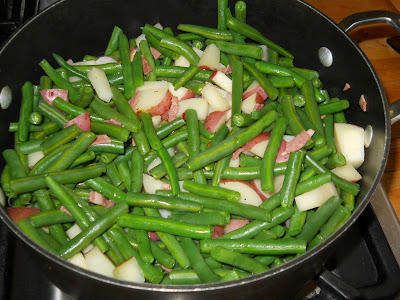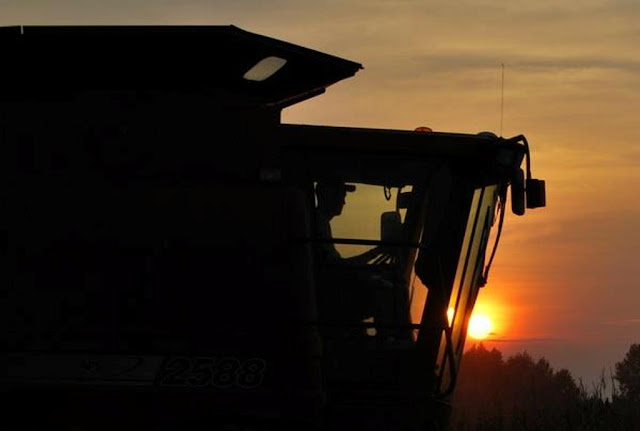 The warmth of mid-June marks the beginning of the time of plenty within gardens and fields, and Hyde County is no exception. Over the last two weeks, I have harvested pickling cucumbers, bell peppers, banana peppers, red potatoes, yellow summer squash, zucchini, strawberries, and peaches. The first blush has colored my Roma tomatoes, and cherry tomatoes are ripening by the juicy handful. The blackberries are slowly working their way from red to deep purple, tempting and jewel-like among gently bending branches. The Mattamuskeet Momma house has been a busy one, with cooking, eating, and preserving our bounty to last us the year long, and according to the boys, nothing is more fun than snap beans.
The warmth of mid-June marks the beginning of the time of plenty within gardens and fields, and Hyde County is no exception. Over the last two weeks, I have harvested pickling cucumbers, bell peppers, banana peppers, red potatoes, yellow summer squash, zucchini, strawberries, and peaches. The first blush has colored my Roma tomatoes, and cherry tomatoes are ripening by the juicy handful. The blackberries are slowly working their way from red to deep purple, tempting and jewel-like among gently bending branches. The Mattamuskeet Momma house has been a busy one, with cooking, eating, and preserving our bounty to last us the year long, and according to the boys, nothing is more fun than snap beans.  I do not plant snap beans in my garden for a couple of reasons. One is that to produce the amount of beans that my family can go through in one year will take more garden space than I am willing to dedicate to it at this point. Believe me, I tried with my first garden. I thought that I had planted more than enough green beans for dinners and the freezer and ended up scavenging through my bush beans to find enough for the pot that night! The main reason, however, is that Hyde County farmers do a splendid job of growing acres and acres of beautiful green beans just a few miles from my house. The arrival of the yellow bean-picker machines signify the time is at hand, and the rumble of eighteen-wheelers down the road, open trailers piled high with tender pods rallies me to load up the boys and head to Mattamuskeet Fresh Produce. A packer and shipper of Hyde County local produce, Mattamuskeet Fresh Produce handles a variety of vegetables, including cabbages, cucumbers, sweet corn, zucchini, squash, and of course, beans. My first year here, my Fairfield ladies in-the-know sent me down the road to purchase my first crate of snap beans, and I have been hooked ever since. The quality is always superb, the sorting is almost amazingly perfect, and the beans are delicious. This year, armed with my camera, my brood and I descended upon the packing plant. The owners welcomed us warmly and showed us the process from bean truck to bean crate.
I do not plant snap beans in my garden for a couple of reasons. One is that to produce the amount of beans that my family can go through in one year will take more garden space than I am willing to dedicate to it at this point. Believe me, I tried with my first garden. I thought that I had planted more than enough green beans for dinners and the freezer and ended up scavenging through my bush beans to find enough for the pot that night! The main reason, however, is that Hyde County farmers do a splendid job of growing acres and acres of beautiful green beans just a few miles from my house. The arrival of the yellow bean-picker machines signify the time is at hand, and the rumble of eighteen-wheelers down the road, open trailers piled high with tender pods rallies me to load up the boys and head to Mattamuskeet Fresh Produce. A packer and shipper of Hyde County local produce, Mattamuskeet Fresh Produce handles a variety of vegetables, including cabbages, cucumbers, sweet corn, zucchini, squash, and of course, beans. My first year here, my Fairfield ladies in-the-know sent me down the road to purchase my first crate of snap beans, and I have been hooked ever since. The quality is always superb, the sorting is almost amazingly perfect, and the beans are delicious. This year, armed with my camera, my brood and I descended upon the packing plant. The owners welcomed us warmly and showed us the process from bean truck to bean crate. |
| The proud owners of Mattamuskeet Fresh Produce! |
 |
| The beans leave the trucks and enter the tumbler. |
The trucks pull around back, where the trailers loaded to the brim with just-picked beans are dumped into the tumbler. From the tumbler, the beans are then sent along conveyor belts to the sorters, a group of diligent workers that remove any beans that aren't up to quality standards. From there, the beans are ferried by additional belts into icy water for "hydro-cooling". This removes the heat from the fields, and ensures the beans stay fresh, plump, and perfectly delicious. The beans are then packed in crates and placed into waiting trucks. The process is a short one, extremely efficient, and is a great way to buy local beans, most of which are harvested from fields only a few miles in each direction from the plant. The boys love coming here to "see the machines" and I love coming home with top quality produce that had been picked from the fields maybe a half and hour before I arrived.
 |
| The beans are sorted by hand to ensure the best quality. |
 |
| The beans are cooled, packed, and sent on their way! |
These beans came home with me, and for the bargain price of $30, I took home two crates which equals about 60 pounds of beans. At a cost of only 50 cents a pound, I will have a freezer full of beans for countless side dishes, soups, stews, and casseroles until June comes around once more. Of course, produce prices change frequently, so you can always call ahead to find out the prices that day, but I would pay a higher price with no hesitation for these plump pods of crunchy goodness. The best part of all of this is that I am helping to support local Hyde County farmers and businesses, something that I believe is key to learning how to live sustainably. It if doesn't come from our own gardens, then the next best thing that we can do is purchase produce from our local farms or businesses. With a little research, anyone can find great local food options without having to resort to purchasing supermarket produce that has traveled across the country, has spent days (if not longer) in transport from field to table, and contributes negatively to the health of our environment. Now that the boys and the beans are all loaded up in the mini-van, a short mile and a half drive sees us at home and ready to begin the fun!

The boys and I start an assembly line to get our beans ready for the freezer. Of course the question arises of "why freeze instead of can?" , and my answer to that boils down to personal preference and canning abilities. Beans, being a vegetable and low acid, require a pressure canner for safe home preservation, something that I do not have any experience with to date. Some of my older lady friends tell me that they have processed beans in boiling water canners for years with no negative side effects, but in my way of thinking, botulism only takes one mistake. To start on the assembly line, we decide who will be "snippers" and who will be "snappers". I remember my mom's hands flying through a bowl of beans - snap off the ends, snap in the middle, and done. I like to use a pair of kitchen shears to snip off the ends as the "snipper" and I then toss the whole bean in a pile in front of my "snapper" who breaks the bean in half and puts them in the bowl. The snapper is the best job for the youngest child, as directing them to break off the ends can result in too little or way too much being broken off the beans. Because the snipping takes longer than the snapping, it works best to have two on snipping. Cole volunteered for snip duty with me this year, and we quickly loaded up a pile of beans in front of Greyson.

Eli did a little of everything - snapping, eating, throwing beans all over the porch, loading up the beans on the back of his toy trucks . . . In this day and age, people tend to reminisce about sitting on their grandmother's porch and snapping beans or shelling peas. There is something about a warm early summer day spent on a shady porch with your family all together working towards common purpose of putting fresh food aside for the winter. It is timeless, and I suppose if you ask 9 out of 10 mothers today if their children would help them snap a bushel or two of beans, the answer would be a resounding no. But I think, in a lot of cases, we sell our children short. If we, acting as parents, take the initiative to turn off the television and video games and say, "this is what we are going to do today, because I love you and I want to make sure that you eat healthy food," then we can start a critical dialogue with our children. I love my boys, and they are no different than other boys their age in terms of interests and energy. The difference is that we constantly talk about food - what is good for you and what isn't, where our food comes from, and why it is better for us and the world around us to grow our own food and eat locally and seasonally. At six and four, Cole and Greyson understand this and make observations and decisions of their own. At 20 months, Eli knows that fresh food looks better and tastes better. He will often be too full for dinner, as he frequently roams my gardens in the late afternoon, cheeks full as a squirrel with ripe berries or crunchy sweet peppers. It is up to us to take our role as parents seriously and lay the groundwork for our children to develop responsibility for their health, as well as for the health of the world in which they live.
 |
| Even Daddy gets into the act! |
I let the beans drain in a large colander and then I place them into freezer bags. When all was said and done, I had 12 gallon bags of snaps for the freezer, a large pot simmering on the stove for dinner, and some great memories to share for years to come. Not bad for a day's worth of work. For as long as I can remember, my mom always made a big pot of snap beans for us to feed off of for a few days, and this is the same recipe that I prepare for my family. In the bottom of a large pot, I sautee about 6 strips of turkey bacon, diced into small pieces, until it is crisp and fragrant (in my mom's recipe it was ham, or country ham, or some type of smoked pork). I add the beans to the pot and put in enough water to cover them. I add salt, pepper, 3-4 cloves of fresh crushed garlic (yes, that's my garlic), five or six diced chopped new potatoes (yes, those are my potatoes - I know, I know, I am way too excited about my garden this year!), and let simmer all together until your desired firmness of beans is obtained (anywhere from half and hour on up). It is simple, delicious, filling, and so good for you!
 |
| My mom's famous snaps and new potatoes - yum! |
Of course, some members in the family may prefer their snap beans raw, but who I am to argue with taste?
















